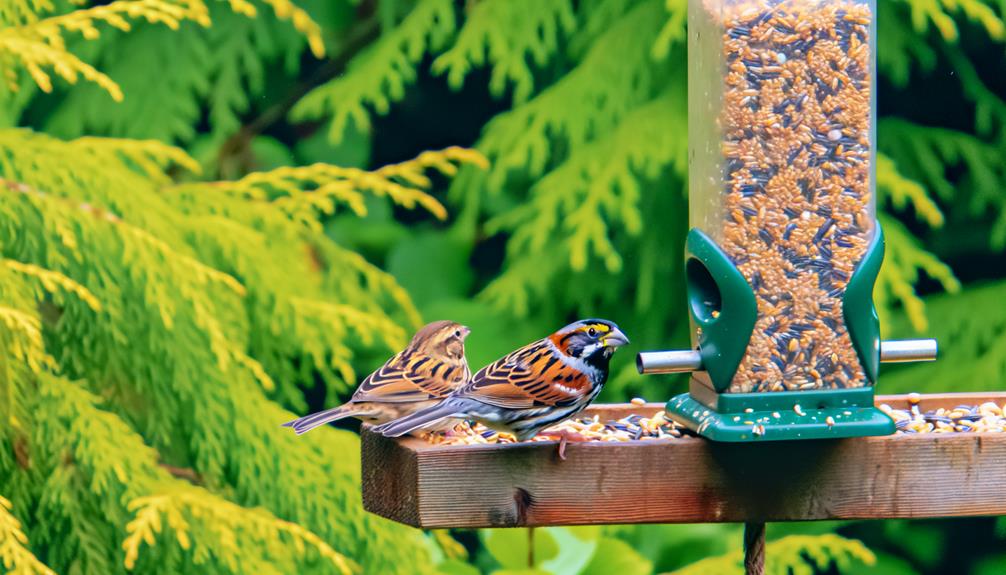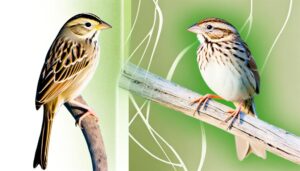How to Identify Male Vs Female Harris’s Sparrows: Quick Guide
Male Harris's Sparrows are distinguished by more pronounced black facial plumage and larger bibs, especially during the breeding season. They also exhibit a larger body size, broader chest, and longer wingspan compared to females.
Sexual dimorphism is evident in size and weight, with males being notably heftier. These attributes are critical for territory establishment and mate selection.
Plumage in males is more vibrant during mating periods, aiding visual identification. Females primarily handle nesting tasks, while males focus on defending territory through vocal and physical displays.
Those intrigued by these behaviors can discover even more nuanced differences.

Key Takeaways
- Male Harris Sparrows have blacker facial plumage and a more pronounced bib compared to females.
- Males are larger in body size, with broader chests and longer wingspans than females.
- Males exhibit more vibrant plumage during the breeding season, while females have more muted coloration.
- Males focus on territorial defense and intricate songs, whereas females primarily engage in nest construction.
- Both sexes have similar foraging techniques but adapt their diets seasonally, with protein-rich insects during breeding.
Physical Appearance

Regarding physical appearance, Harris's sparrow males typically display blacker facial plumage and a more pronounced bib compared to females. In addition to these distinctive features, males generally exhibit a slightly larger body size, which can aid in identification. The males' more robust stature often includes a broader chest and a marginally longer wingspan, though these differences are subtle. Their bill is usually a bit stouter, contributing to an overall more imposing presence.
Female Harris's sparrows, while sharing a similar general coloration pattern, possess less intense black markings, resulting in a softer appearance. Both sexes exhibit a similar brown and white coloration on their back and underparts, ensuring they remain well-camouflaged within their habitat.
Plumage Differences
In Harris's Sparrows, males and females exhibit distinct plumage differences, particularly in coloration variations. Males generally display darker and more pronounced black markings on their heads and throats, while females have comparatively lighter and less defined patterns.
Additionally, both sexes experience seasonal changes in plumage, with breeding season plumage being more vibrant and defined than non-breeding season plumage.
Coloration Variations
Male and female Harris's Sparrows exhibit notable differences in plumage coloration, particularly during the breeding season. Males display a striking black crown, face, and bib that contrast sharply with their white underparts and brownish upperparts. This dramatic black-and-white pattern serves as a visual cue for mate selection and territoriality.
Females, in contrast, possess a more subdued coloration, with a grayish-brown crown and less pronounced black markings. Their underparts are similarly white but lack the stark delineation found in males. These coloration variations not only facilitate gender identification but also play a role in social hierarchies within flocks.
The subtle yet significant differences in plumage between the sexes underscore the complex dynamics of avian life.
Seasonal Changes
As the seasons shift, Harris's Sparrows undergo distinct changes in plumage that reflect their adaptive strategies for survival and reproduction.
During the breeding season, males exhibit bolder, more vivid black facial and throat markings compared to females, signaling their fitness to potential mates. This striking coloration is a vital component of their mating displays.
Conversely, in the non-breeding season, both sexes adopt a more muted, brownish plumage. This cryptic coloration serves to camouflage them from predators during the harsher winter months.
The seasonal changes in plumage aren't merely aesthetic but are essential for the birds' overall life strategy, balancing the need for reproductive success with the imperative of survival in varying environmental conditions.
Size and Weight

Harris's Sparrow exhibits sexual dimorphism in size and weight, with males generally being larger and heavier than females. Detailed observations reveal that this disparity is evident through the following metrics:
- Length: Males measure approximately 17-18 cm, while females range from 16-17 cm.
- Weight: Males typically weigh between 32-39 grams, whereas females average around 28-35 grams.
- Wingspan: The wingspan of males extends to about 25-27 cm, compared to females' 23-25 cm.
- Body Mass Index (BMI): Males exhibit a higher BMI, correlating with their increased body mass and length.
These differences are essential for understanding the species' ecology and behavior, influencing factors like territory establishment and mate selection. Such precise measurements highlight the significant role of size and weight in the life of Harris's Sparrow.
Breeding Season Changes
During the breeding season, Harris sparrows exhibit distinct hormonal shift patterns that influence their behaviors.
Males and females demonstrate notable differences in nesting behaviors and courtship displays, which are critical for reproductive success.
These changes reflect the species' adaptation to their reproductive roles and environmental conditions.
Hormonal Shift Patterns
Understanding the hormonal shift patterns in Harris sparrows during the breeding season reveals significant differences between males and females. These shifts are critical for successful reproduction and vary markedly between genders.
During this period, males and females experience:
- Testosterone Increase in Males: Elevating aggression and territorial behavior.
- Estrogen Surge in Females: Preparing the reproductive system for egg production.
- Seasonal Corticosterone Levels: Affecting both genders, influencing stress responses and energy allocation.
- Prolactin Fluctuations: Supporting parental behaviors, more pronounced in females for nurturing roles.
These hormonal changes underscore the physiological adaptations essential for breeding success. By understanding these shifts, researchers can gain insights into the complex interplay of hormones that drive the reproductive behaviors of Harris sparrows.
Nesting Behavior Differences
As the breeding season commences, male and female Harris sparrows exhibit distinct nesting behaviors that reflect their differing reproductive roles. Females take the primary responsibility for nest construction, selecting hidden, well-shaded sites on the ground and using grasses and moss to create a secure environment for their eggs.
Males, on the other hand, focus on territorial defense, actively warding off potential threats and rival males to secure a safe nesting area. They patrol the vicinity, engaging in vocal displays to assert dominance and maintain the integrity of their territory.
This division of labor optimizes reproductive success, with females dedicating themselves to nurturing future offspring while males provide protection and resources through their vigilance and territorial behavior.
Courtship Display Variations
Marking the onset of the breeding season, male Harris sparrows engage in elaborate courtship displays to attract potential mates, characterized by intricate song patterns and striking plumage displays. These displays are essential for mating success and exhibit significant variation.
Observations indicate that:
- Song Complexity: Males enhance their vocal repertoire, integrating a wider range of notes and rhythms.
- Plumage Brilliance: Feathers become more vivid, with heightened contrast between the black and white markings.
- Territorial Defense: Males aggressively defend their territories, demonstrating dominance through physical displays.
- Courtship Feeding: Males may offer food to females as a demonstration of their ability to provide.
These behaviors, rooted in both visual and auditory signals, serve to maximize reproductive opportunities and secure genetic propagation.
Song and Calls

Male and female Harris's Sparrows exhibit distinct differences in their song and calls, which play an important role in their communication and mating behaviors. Males typically produce more complex and varied songs, often using them to attract females and establish social hierarchy. Their songs consist of multiple phrases that can vary in pitch and tempo.
Females, on the other hand, emit simpler and shorter calls primarily used for maintaining contact with mates and signaling alarm. These vocalizations are less intricate but serve vital functions within their social structure. Both sexes utilize their calls to navigate and interact within their environment, ensuring effective communication and cohesion.
This vocal differentiation underscores the intricate social dynamics of Harris's Sparrows.
Territorial Behavior
In addition to their vocal communication, Harris's Sparrows exhibit pronounced territorial behavior. Both males and females actively defend their territories to secure access to resources and mating opportunities. This territoriality ensures the best conditions for raising offspring and maintaining population stability.
Observations reveal that Harris's Sparrows engage in several key behaviors:
- Boundary Patrols: Both sexes frequently patrol the boundaries of their territories.
- Song Battles: Males often engage in vocal duels to assert dominance.
- Physical Confrontations: When necessary, they resort to physical fights.
- Visual Displays: Postures and plumage displays play an important role in deterring intruders.
These behaviors underscore the importance of territory in the life history of Harris's Sparrows, highlighting their adaptive strategies for survival and reproduction.
Courtship Displays

In Harris Sparrows, courtship displays exhibit distinct differences between males and females. Particularly in mating dance intricacies and vocalization patterns.
Males often engage in more elaborate and vigorous displays. Characterized by specific movements and varied song sequences.
Females, on the other hand, respond with subtler gestures and simpler vocal cues. Facilitating mate selection and bonding.
Mating Dance Differences
During the courtship displays of Harris Sparrows, the males exhibit an elaborate series of flights and calls to attract females. Their mating dance involves several distinct behaviors:
- Aerial Displays: Males perform intricate flight patterns, showcasing agility and strength.
- Wing Flourishes: They fan their wings widely, creating a visual spectacle.
- Ground Displays: Males puff up their chests and strut to appear larger and more dominant.
- Synchrony: Males often synchronize movements with vocalizations to create a cohesive display.
Females evaluate these performances critically, selecting mates based on the precision and vigor of their displays. This selection process guarantees that only the most fit males pass their genes to the next generation, maintaining the species' evolutionary robustness.
Vocalization Patterns
How do Harris Sparrows utilize vocalizations in their courtship displays to communicate fitness and attract mates?
Male Harris Sparrows produce intricate and melodious songs, which serve as indicators of their physical and genetic fitness. These vocalizations are characterized by a series of high-pitched notes and trills that vary in frequency and duration. Females attentively listen to these songs, evaluating the male's ability to maintain consistent and elaborate sequences. Such elaborate vocal patterns reveal the male's overall health, vigor, and suitability as a mate.
Additionally, females also emit softer, less intricate calls during these interactions, possibly to express receptiveness or to further evaluate the male's responses. Therefore, vocalization patterns play a crucial role in the courtship and mating success of Harris Sparrows.
Nesting Roles
Harris Sparrow females mostly assume the responsibility of nest construction, carefully selecting materials and locations to guarantee ideal safety and warmth for their eggs. Their nesting behavior is characterized by meticulous attention to detail, ensuring best conditions for their offspring's development. Especially, the nests are often situated in concealed areas to protect against predators.
Key aspects of Harris Sparrow nesting roles include:
- Material Selection: Females choose fine grasses, twigs, and feathers to create a sturdy, insulated nest.
- Location Choice: Nests are typically placed in low shrubs or dense vegetation to provide camouflage.
- Nest Structure: The nest is cup-shaped, offering a secure environment for the eggs.
- Incubation: Females mainly undertake the incubation process, maintaining the required temperature for egg development.
This nesting strategy exemplifies their adaptive behaviors in their natural habitat.
Feeding Habits

Regularly displaying a diverse diet, Harris Sparrows primarily forage for seeds, fruits, and insects to sustain their nutritional needs. They demonstrate a keen ability to adapt their feeding habits based on seasonal availability.
During the breeding season, insects become an important protein source, supporting reproductive health. Conversely, in colder months, these birds shift towards a diet rich in seeds and berries, which provide essential energy reserves.
Males and females don't significantly differ in their foraging behavior, both displaying similar techniques and preferences. They often forage on the ground, using a hopping motion to uncover hidden food items.
Their versatile diet and adaptive foraging strategies highlight their resilience and capacity to thrive in varied habitats.
Migration Patterns
During autumn, Harris Sparrows embark on a southward journey, traveling from their breeding grounds in the boreal forests of Canada to wintering habitats in the central United States. This journey is crucial for their survival, providing access to more abundant food resources and milder climates.
Noteworthy aspects of their migration include:
- Timing: The migration typically starts in late September and wraps up by early November.
- Routes: Harris Sparrows mainly follow the Central Flyway, a major migratory pathway.
- Distances: They cover distances varying from 1,500 to 2,500 kilometers.
- Stopover Sites: Key stopover sites include wetlands and grasslands where they can rest and refuel.
These patterns guarantee Harris Sparrows maintain their population and thrive across varying seasonal environments.
Conclusion
In summation, the Harris's sparrow exhibits intriguing distinctions between males and females, particularly in plumage and behavioral roles.
During one spring field study, researchers observed a male's striking black bib as a beacon of dominance, akin to a captain's insignia, guiding his flock.
Such differences underscore not just the biological divergence but also the social dynamics within their species.
These intricate patterns of behavior and appearance reveal the nuanced interplay of nature's design in avian life.






